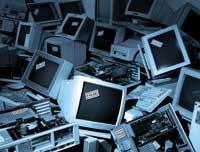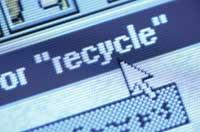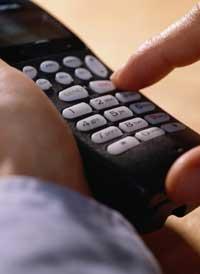Computers, symbol of progress and enemy of the environment
Multimedia has reached everywhere and it is impossible to imagine our life without the computer. But besides being essential, the computer material must be continuously renewed. In a few years there is a memory too small, too old for the last program, game or internet connection...

Because it does not serve at all, you feel the need to buy a new one as soon as possible, and by not missing the aids for it, they change without thinking twice. The old computer, on the contrary, is working, but it is so slow and old that giving someone also gives shame. Therefore, decide what to do with the old computer does not give headaches, strips it to the trash and is already!
But, the computer is nothing more than a working tool, and all the innovations that are made to facilitate the work can only be good. Nobody puts it, but do you know that in 1998 6 million tons of electrical and electronic waste were deposited in the European Union? In addition, this figure is increasing between 3% and 5% each year, estimating an increase of 16-28% for 2003. A lot of trash and dangerous substances are accumulating for the moment without management planning. In fact, 90% of the incinerated or deposited computer material in landfill does not receive any previous treatment.
Dangerous compounds Dangerous compounds
The normal user only sees the plastic housing of the computer when working, but it is known that the computer base is in electrical and electronic materials. Entering and exploring the guts, you will find the tube of cathodic rays, printed circuits, cables, firewalls, mercury switch, accumulators and batteries, etc. And harmful substances for the environment and human health in these compounds are scarce: heavy metals (mercury, cadmium, lead, chromium), halogen substances (chlorofluorohydrocarbons CFC, polyvinyl PVC chloride, biphenyl polychloride PCB...), bromine, arsenic and asbestos prerequisites.

Lead, cadmium, mercury and chromium are heavy metals that accumulate in the trophic chain. At high levels of concentration all are toxic, but it is not enough to cause allergies and cancers like asthma. It is important to properly control the concentrations of heavy metals through aquifers, since otherwise they can reach the human being by introducing them into the trophic chain of microorganisms and plants. As for lead, it is very difficult to measure the importance of lead sources, and although for this purpose it would be necessary to perform local geochemical analysis, it is considered that electronic and electrical material is a source of 40% of the amount of lead present in landfills.
On the other hand, the very used bromine firewalls in computer circuits, cables and plastics, when incinerated produce dioxin and furan. These firewalls account for about 20% of the plastic volume of computers.
It is considered that, without having exhaustive knowledge of the effects of substances from electrical and electronic materials, they have harmful effects on the environment and health. But, however, what can the conscious consumer who needs to buy a new computer so as not to throw his computer into the trash? Is there any legislation in this regard or place for collection and recycling?
For the moment, incineration or deposit in landfill

The reports that show the severity of the problem are not lacking, but this garbage ends up incinerated or deposited in landfills. The incineration of these waste results in the emission of heavy metals and the emission of dioxins and furans. A report from the European Parliament estimates that 36 tons of mercury and 16 tons of cadmium are emitted annually in the European Union. In addition, computer screens and televisions generate significant energy losses in the incineration process. For example, a kilo of cathodic ray tube produces a loss of 400 kJ.
The same can be said about landfills, since, in short, the risk of substances present in electrical and electronic materials does not disappear in the same way. Obviously, the damage is greater when landfills are uncontrolled or technically incorrectly conditioned. The main problem is due to the gases that are generated and the substances that arrive at aquifers, such as the aforementioned heavy metals.
To date, the two main solutions that have been given to most (or all) of the garbage are, therefore, not suitable and evident the need to collect and recycle these materials. In fact, as mentioned above, at the moment only 10% have some treatment prior to incineration and deposit in landfill. PVC, for example, at the risk that firewalls can throw dioxin and furan, is very little recycled. It is said that it is very difficult to separate the ignores, and as we know, a company in the area charges 26 pesetas the kilo of PVC it treats. Of course, what would promise to collect and recycle computers also goes back, because one thing is that they are willing to work on kissing and another very different is that they pay for work.
Need for new legislation

In 2000, the European Union developed a new directive to protect the environment and human health. With the new Directive, it is intended to encourage producers of electrical and electronic materials to assume the responsibilities that correspond to them in the management of these waste, which translates into a greater survival and the use of less harmful substances. Without leaving everything in the hands of producers, the new directive reduces the use of dangerous substances and defines pre-incineration treatment. In addition, a joint planning of collection of computer material in all countries is to be implemented for further recycling.
At the moment, Holland, Denmark, Sweden, Austria, Belgium and Italy have developed new laws and Finland and Germany are on the way. Other countries will also have to start thinking about where and how to recycle computers that facilitate work and also give work.
Different colors but similar damages

The technological waste is classified in three colours: white, brown and grey. The white line includes fridges, washing machines, ovens and kitchens. In a medium city (between 300,000 and 400,000 inhabitants) every year about a thousand ‘white’ waste is thrown to the detriment of the environment. For example, although paradoxical, the refrigerators emit gases that influence climate change, until CFC gases were banned in 1987 and subsequently HCF gases that have not been more beneficial (see Natura 19.11.2000).
On the brown line there are televisions. In addition to the televisions that people broadcast on their own, every year in a medium city around 1,100 televisions are collected.
Finally, computers and computer equipment form a gray line. Still, in quantity, they are not the most numerous technological waste, but no one doubts that they will soon arrive at that domain.
Mobile phones go the same way as computers. The market is being renewed at a breakneck speed and only in Gipuzkoa this year is estimated to be emitted 200,000 mobile. Mobile phones have liquid crystal displays and batteries with toxic elements, so the antennas that have generated so much controversy are not the only problems. There are still no special containers to throw old mobile, but they take them in some stores and can be deposited in the same container as batteries.
Published in the supplement Natura de Gara
Buletina
Bidali zure helbide elektronikoa eta jaso asteroko buletina zure sarrera-ontzian











